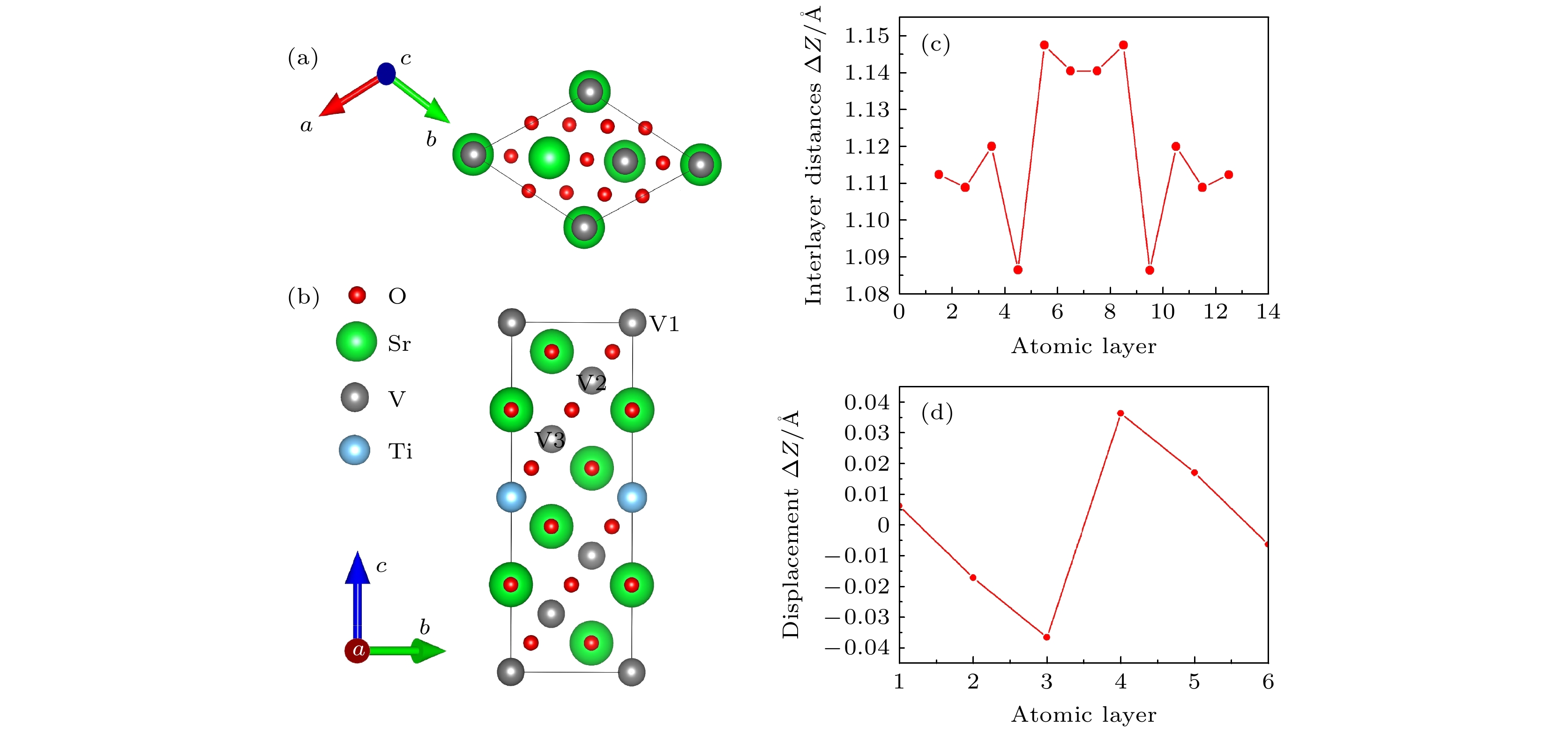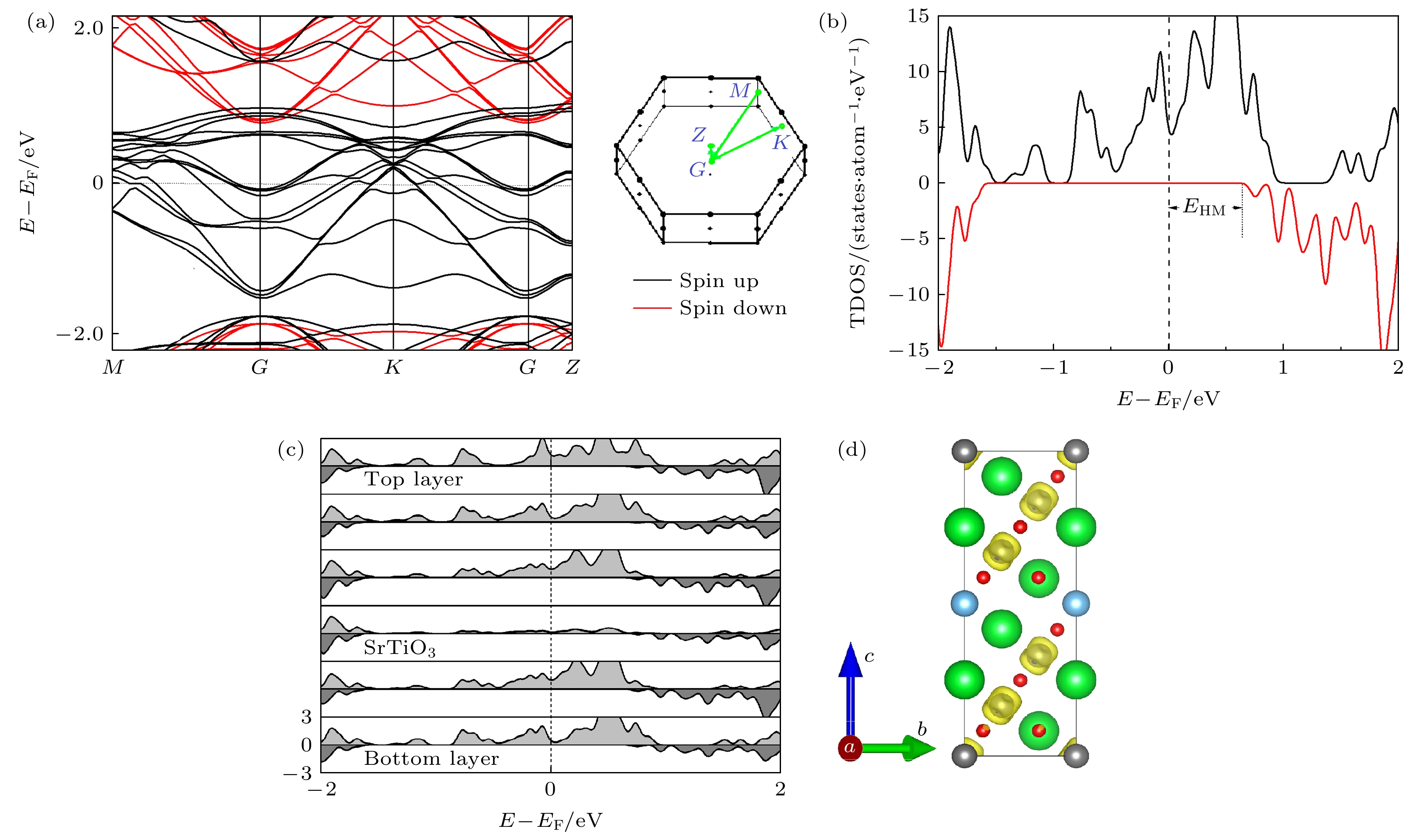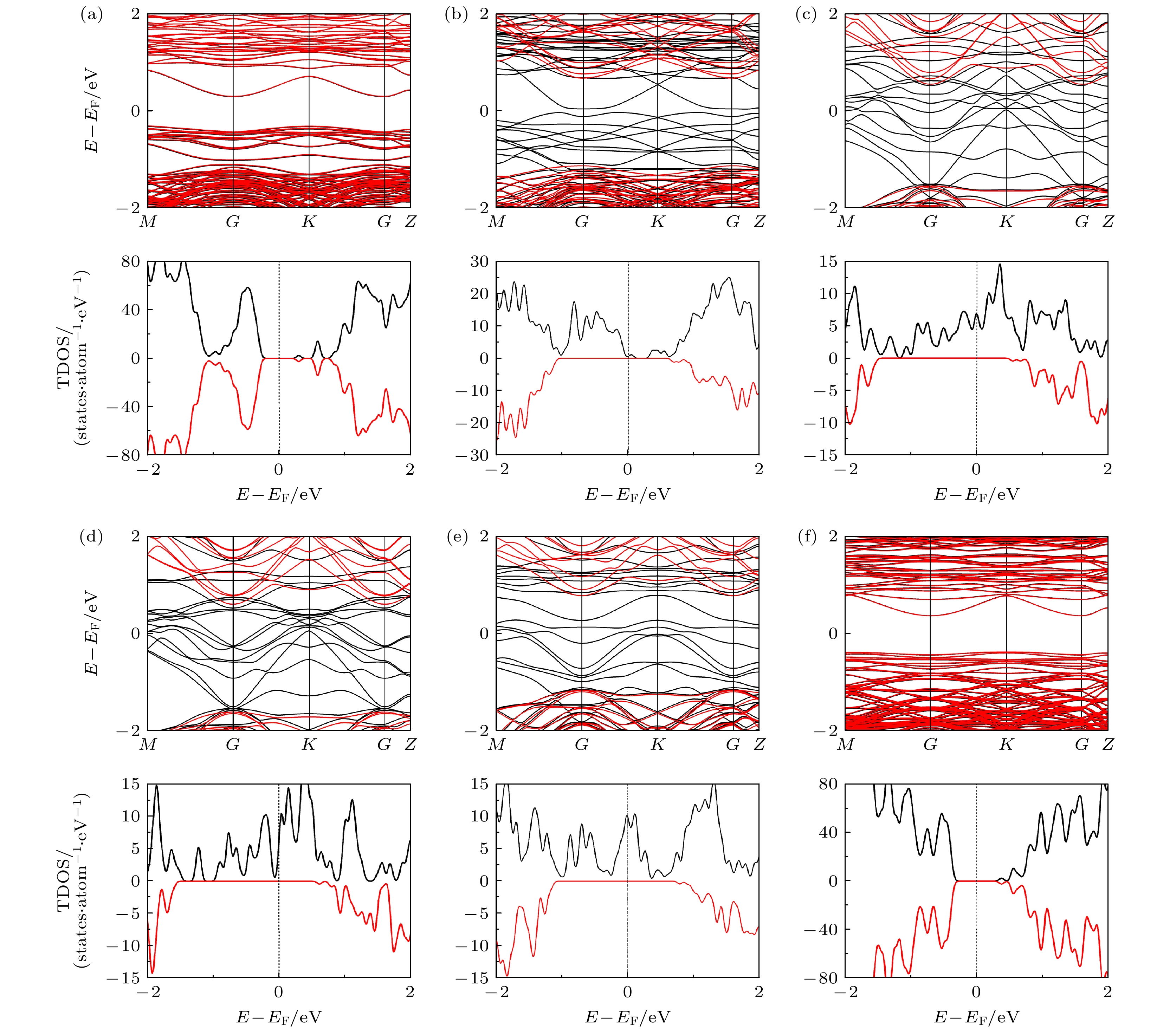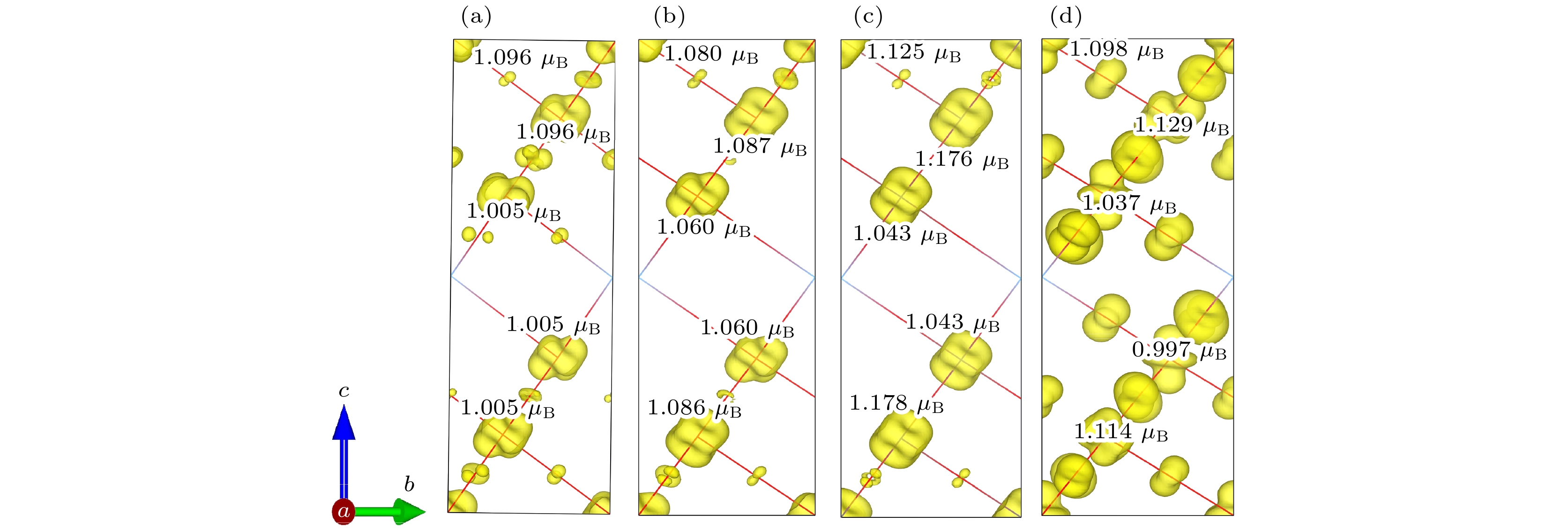-
Perovskite heterostructure has a honeycomb lattice when a bilayer along the [111] direction is considered. The material usually presents a wealth of unique properties. Recently, (111)-oriented perovskite heterojunctions have received more and more attention. In this work, the first-principle calculations are employed to investigate the electronic and magnetic properties of (SrVO3)5/(SrTiO3)1 (111) heterostructure. The calculations show that the ground state of (SrVO3)5/(SrTiO3)1 (111) heterostructure is a half-metallic ferromagnet. Further study reveals the existence of different correlated-electron ground states in (SrVO3)5/(SrTiO3)1 (111) heterostructure, and they can be tuned by changing in-plane strain and interfacial cation intermixing. This system can keep half-metallic properties under difffferent in-plane strains from –4% to 2%. The half-metallic properties mainly come from V 3d electrons. The ground state of the system can evolve from a half-metal to a antiferromagnetic insulator if the in-plane compressive (tensile) strain is added up to 8% (4%). The interfacial Ti-V intermixing can destroy the original half-metallic properties, and the system exhibits a ferromagnetic insulator phase. These results demonstrate that the system has potential applications in the field of spintronics, and provide a theoretical reference for the use of (SrVO3)5/(SrTiO3)1 (111) heterostructures to explore quantum phase transitions.
-
Keywords:
- heterostructures /
- in-plane strain /
- metal-insulator transition /
- half-metallic ferromagnets
[1] Ohtomo A, Hwang H Y 2004 Nature 427 423
 Google Scholar
Google Scholar
[2] Zhang X J, Chen P, Liu B G 2017 J. Mater. Chem. C 5 9898
 Google Scholar
Google Scholar
[3] Davis S, Huang Z, Han K, Ariando, Venkatesan T, Chandrasekhar V 2018 Phys. Rev. B 98 024504
[4] Kim D H, Kim D W, Kang B S, Noh T W, Lee D R, Lee K B, Lee S J 2000 Solid State Commun. 114 473
 Google Scholar
Google Scholar
[5] Dai Q, Lüders U, Frésard R, Eckern U, Schwingenschlögl U 2018 Adv. Mater. Interfaces 5 1701169
 Google Scholar
Google Scholar
[6] Pardo V, Pickett W E 2010 Phys. Rev. B 81 245117
 Google Scholar
Google Scholar
[7] James A D N, Aichhorn M, Laverock J 2021 Phys. Rev. Res. 3 023149
 Google Scholar
Google Scholar
[8] Yang Z, Ko C, Ramanathan S 2011 Annu. Rev. Mater. Res. 41 337
 Google Scholar
Google Scholar
[9] Xu R, Ji Y, Bouchilaoun R, Qian F, Li M, Zhang X, Tang R, Zhao R, Misra S, Wang H, Li W, Kan C, Shi D, Fan J, Yang H 2019 Ceram. Int. 45 11304
 Google Scholar
Google Scholar
[10] Roth J, Kuznetsova T, Miao L X, Pogrebnyakov1 A, Alem1 N, Engel-Herbert R 2021 APL Mater. 9 021114
 Google Scholar
Google Scholar
[11] Mitsuhashi T, Minohara M, Yukawa R, Kitamura M, Horiba K, Kobayashi M, Kumigashira H 2016 Phys. Rev. B 94 125148
 Google Scholar
Google Scholar
[12] Jacobs R, Booske J, Morgan D 2016 Adv. Funct. Mater. 26 5471
 Google Scholar
Google Scholar
[13] 袁烺, 肖嘉慧, 谢颖 2017 中国科技论文 12 2826
 Google Scholar
Google Scholar
Yuan L, Xiao J H, Xie Y 2017 Chin. Sci. Paper 12 2826
 Google Scholar
Google Scholar
[14] Shen M L, Weng Y K, Yi Y W, Geng Q F, Yan W, Wang H Y, Yang J P, Li X 2019 J. Appl. Phys. 126 085307
 Google Scholar
Google Scholar
[15] Weng Y K, Zhang J J, Gao B, Dong S 2017 Phys. Rev. B 95 155117
 Google Scholar
Google Scholar
[16] Xiao D, Zhu W, Ran Y, Nagaosa N, Okamoto S 2011 Nat. Commun. 2 1
 Google Scholar
Google Scholar
[17] Okamoto S, Zhu W, Nomura Y, Arita R, Xiao D, Nagaosa N 2014 Phys. Rev. B 89 195121
 Google Scholar
Google Scholar
[18] Chen R, Lee S B, Balents L 2013 Phys. Rev. B 87 161119
[19] Doennig D, Pickett W E, Pentcheva R 2014 Phys. Rev. B 89 121110
[20] Du Y L, Wang C L, Li J C, Zhang X Z, Wang F N, Zhu Y H, Yin N, Mei L M 2015 Comput. Mater. Sci. 99 57
 Google Scholar
Google Scholar
[21] 李永宁, 谢逸群, 王音 2021 物理学报 70 227701
 Google Scholar
Google Scholar
Li Y N, Xie Y Q, Wang Y 2021 Acta Phys. Sin. 70 227701
 Google Scholar
Google Scholar
[22] 胡海洋, 陈吉堃, 邵飞, 吴勇, 孟康康, 李志鹏, 苗君, 徐晓光, 王嘉鸥, 姜勇 2019 物理学报 68 026701
 Google Scholar
Google Scholar
Hu H Y, Chen J K, Shao F, Wu Y, Meng K K, Li Z P, Miao J, Xu X G, Wang J O, Jiang Y 2019 Acta Phys. Sin. 68 026701
 Google Scholar
Google Scholar
[23] Kalabukhov A S, Boikov Y A, Serenkov I T, Sakharov V I, Popok V N, Gunnarsson R, Borjesson J, Ljustina N, Olsson E, Winkler D, Claeson T 2009 Phys. Rev. Lett. 103 146101
 Google Scholar
Google Scholar
[24] Qiao L, LDroubay T C, Shutthanandan V, Zhu Z, Sushko P V, Chambers S A 2010 J. Phys. Condens. Matter 22 312201
 Google Scholar
Google Scholar
[25] Li J, Yin D, Li Q, Sun R 2017 Phys. Chem. Chem. Phys. 19 6945
 Google Scholar
Google Scholar
[26] Kresse G, Furthmüller J 1996 Phys. Rev. B 54 11169
 Google Scholar
Google Scholar
[27] Perdew J P, Burke K, Ernzerhof M 1996 Phys. Rev. Lett. 77 3865
 Google Scholar
Google Scholar
[28] Blöchl P E 1994 Phys. Rev. B 50 17953
 Google Scholar
Google Scholar
[29] Anisimov V I, Zaanen J, Andersen O K 1991 Phys. Rev. B 44 943
 Google Scholar
Google Scholar
[30] Du Y L, Wang C L, Li J C, Xu P P, Zhang X H, Liu J, Su W B, Mei L M 2014 Chin. Phys. B 23 087302
 Google Scholar
Google Scholar
[31] Park S Y, Kumar A, Rabe K M 2017 Phys. Rev. Lett. 118 087602
 Google Scholar
Google Scholar
[32] Monkhorst H J, Pack J D 1976 Phys. Rev. B 13 5188
 Google Scholar
Google Scholar
[33] Shein I R, Kozhevnikov V L, Ivanovskii A L 2008 Solid State Sci. 10 217
 Google Scholar
Google Scholar
[34] Chandra H K, Guo G Y 2017 Phys. Rev. B 95 134448
[35] Shein I R, Ivanovskii A L 2007 Phys. Lett. A 371 155
 Google Scholar
Google Scholar
[36] Musa Saad H E M 2021 Bull. Mater. Sci. 44 1
 Google Scholar
Google Scholar
[37] Beltrán J I, Muñoz M C 2017 Phys. Rev. B 95 245120
 Google Scholar
Google Scholar
[38] Du Y L, Bu H X, Ji C J, Zhang X M, Li C L, Fang X N 2019 Phys. Chem. Chem. Phys. 21 18170
 Google Scholar
Google Scholar
[39] De Luca G M, Di Capua R, Di Gennaro E, Sambri A, Miletto Granozio F, Ghiringhelli G, Betto D, Piamonteze C, Brookes N B, Salluzzo M 2018 Phys. Rev. B 98 115143
 Google Scholar
Google Scholar
[40] Ye H S, Zhu Y J, Bai D M, Zhang J T, Wu X S, Wang J L 2021 Phys. Rev. B 103 035423
 Google Scholar
Google Scholar
[41] Yoshida T, Kobayashi M, Yoshimatsu K, Kumigashira H, Fujimori A 2016 J. Electron. Spectrosc. 208 11
 Google Scholar
Google Scholar
[42] Ma H J H, Zhou J, Yang M, Liu Y, Zeng S W, Zhou W X, Zhang L C, Venkatesan T, FengY P, Ariando A 2017 Phys. Rev. B 95 155314
 Google Scholar
Google Scholar
[43] Liu Z T Y, Podraza N J, Khare S V, Sarin P 2018 Comput. Mater. Sci. 144 139
 Google Scholar
Google Scholar
[44] Oshima M 2014 Appl. Sci. Converg. Technol. 23 317
 Google Scholar
Google Scholar
[45] Wang J, Gauquelin N, Huijben M, Verbeeck J, Rijnders G, Koster G 2020 Appl. Phys. Lett. 117 133105
 Google Scholar
Google Scholar
-
图 1 (a), (b) (SVO)5/(STO)1 (111)异质结的(a)俯视图和(b)侧视图; (c) 沿c轴方向, 相邻原子层之间的距离; (d) SrO3原子层中锶离子相对于氧离子在c轴方向的位移, ΔZ = Z(Sri) – Z(Oi), 其中Z(Sri)是第i层SrO3中锶离子的纵坐标值, Z(Oi)是第i层SrO3中氧离子的纵坐标平均值
Figure 1. (a) Top view of the (SVO)5/(STO)1(111) heterostructure with in-plane 1 × 1 unit cells; (b) side view of (SVO)5/(STO)1(111) heterostructure; (c) the interplanar distance between consecutive planes; (d) the displacement of Sr cation relative to O ions in each SrO3 layers, ΔZ = Z(Sri) – Z(Oi), where Z(Sri) is the value of the Sr cation and Z(Oi) is the average value of the O atoms in a given SrO3 layer i along the c axis.
图 2 (a) (SVO)5/(STO)1(111)异质结费米面附近的能带结构, 高对称点如图中第一布里渊区所示; (b) 费米面附近的总态密度图, 费米能位于0 eV处(用黑色虚线表示); (c) (SVO)5/(STO)1(111)各原子层在费米面附近的态密度图, 图中自旋向上的电子态密度由浅灰色区域表示, 自旋向下的电子态密度由深灰色区域表示, 黑色虚线表示费米能级; (d) 费米面附近([EF –1.5 eV, EF])的电荷密度图, 图中三维电荷密度的isosurface值取0.015 e/bohr3
Figure 2. (a) Band structures of (SVO)5/(STO)1(111) along with the special points in the Brillouin zone. The inset shows the Brillouin zone and the special points. (b) Total density of states (TDOS) near the Fermi level. The Fermi level is located at 0 eV (dotted black line). (c) Layer-resolved partial density of states (PDOS) of (SVO)5/(STO)1(111). (d) Projections of the carrier density (yellow contour) of (SVO)5/(STO)1(111) heterostructure. The isosurface values are chosen as 0.015 e/bohr3. The carrier densities are calculated from contributions within an energy window of [EF –1.5 eV, EF].
图 3 (a) V, Ti, Sr, O原子的态密度图; (b) V原子3 d轨道的分波态密度图, 其中, V1, V2, V3与图1(b)中标注一致; (c) O原子2p轨道的分波态密度图; (d) Ti原子3d轨道的分波态密度图
Figure 3. (a) Densities of states near the Fermi level of V, Ti, Sr and O. (b) Partial densities of states (PDOS) of V 3d orbitals. V1, V2, V3 are the same as those in Fig. 1(b). (c) PDOS of the O 2p orbitals. (d) PDOS of the Ti 3d orbitals.
图 4 (a) 面内压缩应变为8%和面内拉伸应变为4%时能量最低的反铁磁序. 红色小球代表自旋向上的V原子, 绿色小球代表自旋向下的V原子, 蓝色小球代表Ti原子. (b) 在不同的面内应变条件下, 沿c轴方向各原子层之间的距离
Figure 4. (a) The most stable AFM structure of (SVO)5/(STO)1(111) under the in-plane compressive (tensile) strain of 8% (4%). The red and green balls represent the spin-up and spin-down V atoms, respectively. Blue balls represent Ti atoms. (b) The interplanar distance along the c axis between consecutive planes under different in-plane strains.
图 5 (SVO)5/(STO)1(111)异质结在不同面内应变下费米面附近的能带结构和总态密度图 (a) η = –8%; (b) η = –7%; (c) η = –4%; (d) η = –2%; (e) η = 2%; (f) η = 4%. 高对称点如图2(a)中第一布里渊区所示, 对应面内应变下的总态密度图显示在能带图的下面. 黑色实线和红色实线分别代表自旋向上和自旋向下, 费米能级用虚线表示
Figure 5. Band structures and total density of states near the Fermi level of (SVO)5/(STO)1(111) under different in-plane strains: (a) η = –8%; (b) η = –7%; (c) η = –4%; (d) η = –2%; (e) η = 2%; (f) η = 4%. The Brillouin zone is the same as that in Fig. 2(a). Black and red lines are spin-up and spin-down states, respectively. The Fermi level is located at 0 eV (dotted black line).
图 6 不同面内应变下(SVO)5/(STO)1(111)异质结中各原子的态密度图 (a) η = –8%; (b) η = –7%; (c) η = –4%; (d) η = –2%; (e) η = 2%; (f) η = 4%. 不同颜色的实线代表不同原子的态密度图. 态密度图中上部为上自旋态密度, 下部为下自旋态密度, 费米能级用黑色虚线表示
Figure 6. DOS near the Fermi level of the atoms in (SVO)5/(STO)1(111) under different in-plane strains: (a) η = –8%; (b) η = –7%; (c) η = –4%; (d) η = –2%; (e) η = 2%; (f) η = 4%. Different orbitals are marked by different colored lines. The Fermi level is indicated by the dashed line.
图 7 不同面内应变下铁磁半金属(SVO)5/(STO)1(111)异质结中费米面附近([EF –1.5 eV, EF])的电荷密度图和各V原子的磁矩 (a) η = –4%; (b) η = –2%; (c) η = 0%; (d) η = 2%. 图中三维电荷密度的isosurface值取 0.015 e/bohr3
Figure 7. Projections of the carrier density (yellow contour) and magnetic moments of V atoms of (SVO)5/(STO)1(111) heterostructure under different in-plane strains: (a) η = –4%; (b) η = –2%; (c) η = 0%; (d) η = 2%. The atoms are not shown. The isosurface values are chosen as 0.015 e/bohr3. The carrier densities are calculated from contributions within an energy window of [EF –1.5 eV, EF]
图 8 不同面内应变下(SVO)5/(STO)1(111)异质结中V 3d轨道的态密度图 (a) η = –8%; (b) η = –7%; (c) η = –4%; (d) η = –2%; (e) η = 2%; (f) η = 4%. 不同颜色的实线代表不同轨道; 态密度图中上部为上自旋态密度, 下部为下自旋态密度, 费米能级用虚线表示
Figure 8. Projected density of states of V 3d near the Fermi level of (SVO)5/(STO)1(111) under different in-plane strains: (a) η = –8%; (b) η = –7%; (c) η = –4%; (d) η = –2%; (e) η = 2%; (f) η = 4%. Different orbitals are marked by different colored lines. The Fermi level is indicated by the dashed line.
图 9 (a) 界面Ti-V扩散掺杂模型Ⅰ的(SVO)5/(STO)1(111)侧视图(图中只显示Ti和V原子); (b) 模型Ⅰ费米面附近的总态密度, 费米能位于0 eV处(用黑色虚线表示); (c) 模型Ⅰ各原子的态密度图; (d) 界面Ti-V扩散掺杂模型Ⅱ的(SVO)5/(STO)1 (111)侧视图(图中只显示Ti和V原子); (e) 模型Ⅱ费米面附近的总态密度, 费米能位于0 eV处(用黑色虚线表示); (f) 模型Ⅱ各原子的态密度图, 不同颜色的实线代表不同原子的态密度图. 态密度图中上部为上自旋态密度, 下部为下自旋态密度, 费米能级用虚线表示
Figure 9. (a) Side view of (SVO)5/(STO)1(111) heterostructure Ⅰ with interfacial Ti-V intermixing; (b) total density of states of heterostructure Ⅰ near the Fermi level; (c) DOS of atoms in heterostructure Ⅰ near the Fermi level; (d) side view of (SVO)5/(STO)1 (111) heterostructure Ⅱ with interfacial Ti-V intermixing; (e) total density of states of heterostructure Ⅱ near the Fermi level; (f) DOS of atoms in heterostructure Ⅱ near the Fermi level. Different orbitals are marked by different colored lines. The Fermi level is indicated by the dashed line.
-
[1] Ohtomo A, Hwang H Y 2004 Nature 427 423
 Google Scholar
Google Scholar
[2] Zhang X J, Chen P, Liu B G 2017 J. Mater. Chem. C 5 9898
 Google Scholar
Google Scholar
[3] Davis S, Huang Z, Han K, Ariando, Venkatesan T, Chandrasekhar V 2018 Phys. Rev. B 98 024504
[4] Kim D H, Kim D W, Kang B S, Noh T W, Lee D R, Lee K B, Lee S J 2000 Solid State Commun. 114 473
 Google Scholar
Google Scholar
[5] Dai Q, Lüders U, Frésard R, Eckern U, Schwingenschlögl U 2018 Adv. Mater. Interfaces 5 1701169
 Google Scholar
Google Scholar
[6] Pardo V, Pickett W E 2010 Phys. Rev. B 81 245117
 Google Scholar
Google Scholar
[7] James A D N, Aichhorn M, Laverock J 2021 Phys. Rev. Res. 3 023149
 Google Scholar
Google Scholar
[8] Yang Z, Ko C, Ramanathan S 2011 Annu. Rev. Mater. Res. 41 337
 Google Scholar
Google Scholar
[9] Xu R, Ji Y, Bouchilaoun R, Qian F, Li M, Zhang X, Tang R, Zhao R, Misra S, Wang H, Li W, Kan C, Shi D, Fan J, Yang H 2019 Ceram. Int. 45 11304
 Google Scholar
Google Scholar
[10] Roth J, Kuznetsova T, Miao L X, Pogrebnyakov1 A, Alem1 N, Engel-Herbert R 2021 APL Mater. 9 021114
 Google Scholar
Google Scholar
[11] Mitsuhashi T, Minohara M, Yukawa R, Kitamura M, Horiba K, Kobayashi M, Kumigashira H 2016 Phys. Rev. B 94 125148
 Google Scholar
Google Scholar
[12] Jacobs R, Booske J, Morgan D 2016 Adv. Funct. Mater. 26 5471
 Google Scholar
Google Scholar
[13] 袁烺, 肖嘉慧, 谢颖 2017 中国科技论文 12 2826
 Google Scholar
Google Scholar
Yuan L, Xiao J H, Xie Y 2017 Chin. Sci. Paper 12 2826
 Google Scholar
Google Scholar
[14] Shen M L, Weng Y K, Yi Y W, Geng Q F, Yan W, Wang H Y, Yang J P, Li X 2019 J. Appl. Phys. 126 085307
 Google Scholar
Google Scholar
[15] Weng Y K, Zhang J J, Gao B, Dong S 2017 Phys. Rev. B 95 155117
 Google Scholar
Google Scholar
[16] Xiao D, Zhu W, Ran Y, Nagaosa N, Okamoto S 2011 Nat. Commun. 2 1
 Google Scholar
Google Scholar
[17] Okamoto S, Zhu W, Nomura Y, Arita R, Xiao D, Nagaosa N 2014 Phys. Rev. B 89 195121
 Google Scholar
Google Scholar
[18] Chen R, Lee S B, Balents L 2013 Phys. Rev. B 87 161119
[19] Doennig D, Pickett W E, Pentcheva R 2014 Phys. Rev. B 89 121110
[20] Du Y L, Wang C L, Li J C, Zhang X Z, Wang F N, Zhu Y H, Yin N, Mei L M 2015 Comput. Mater. Sci. 99 57
 Google Scholar
Google Scholar
[21] 李永宁, 谢逸群, 王音 2021 物理学报 70 227701
 Google Scholar
Google Scholar
Li Y N, Xie Y Q, Wang Y 2021 Acta Phys. Sin. 70 227701
 Google Scholar
Google Scholar
[22] 胡海洋, 陈吉堃, 邵飞, 吴勇, 孟康康, 李志鹏, 苗君, 徐晓光, 王嘉鸥, 姜勇 2019 物理学报 68 026701
 Google Scholar
Google Scholar
Hu H Y, Chen J K, Shao F, Wu Y, Meng K K, Li Z P, Miao J, Xu X G, Wang J O, Jiang Y 2019 Acta Phys. Sin. 68 026701
 Google Scholar
Google Scholar
[23] Kalabukhov A S, Boikov Y A, Serenkov I T, Sakharov V I, Popok V N, Gunnarsson R, Borjesson J, Ljustina N, Olsson E, Winkler D, Claeson T 2009 Phys. Rev. Lett. 103 146101
 Google Scholar
Google Scholar
[24] Qiao L, LDroubay T C, Shutthanandan V, Zhu Z, Sushko P V, Chambers S A 2010 J. Phys. Condens. Matter 22 312201
 Google Scholar
Google Scholar
[25] Li J, Yin D, Li Q, Sun R 2017 Phys. Chem. Chem. Phys. 19 6945
 Google Scholar
Google Scholar
[26] Kresse G, Furthmüller J 1996 Phys. Rev. B 54 11169
 Google Scholar
Google Scholar
[27] Perdew J P, Burke K, Ernzerhof M 1996 Phys. Rev. Lett. 77 3865
 Google Scholar
Google Scholar
[28] Blöchl P E 1994 Phys. Rev. B 50 17953
 Google Scholar
Google Scholar
[29] Anisimov V I, Zaanen J, Andersen O K 1991 Phys. Rev. B 44 943
 Google Scholar
Google Scholar
[30] Du Y L, Wang C L, Li J C, Xu P P, Zhang X H, Liu J, Su W B, Mei L M 2014 Chin. Phys. B 23 087302
 Google Scholar
Google Scholar
[31] Park S Y, Kumar A, Rabe K M 2017 Phys. Rev. Lett. 118 087602
 Google Scholar
Google Scholar
[32] Monkhorst H J, Pack J D 1976 Phys. Rev. B 13 5188
 Google Scholar
Google Scholar
[33] Shein I R, Kozhevnikov V L, Ivanovskii A L 2008 Solid State Sci. 10 217
 Google Scholar
Google Scholar
[34] Chandra H K, Guo G Y 2017 Phys. Rev. B 95 134448
[35] Shein I R, Ivanovskii A L 2007 Phys. Lett. A 371 155
 Google Scholar
Google Scholar
[36] Musa Saad H E M 2021 Bull. Mater. Sci. 44 1
 Google Scholar
Google Scholar
[37] Beltrán J I, Muñoz M C 2017 Phys. Rev. B 95 245120
 Google Scholar
Google Scholar
[38] Du Y L, Bu H X, Ji C J, Zhang X M, Li C L, Fang X N 2019 Phys. Chem. Chem. Phys. 21 18170
 Google Scholar
Google Scholar
[39] De Luca G M, Di Capua R, Di Gennaro E, Sambri A, Miletto Granozio F, Ghiringhelli G, Betto D, Piamonteze C, Brookes N B, Salluzzo M 2018 Phys. Rev. B 98 115143
 Google Scholar
Google Scholar
[40] Ye H S, Zhu Y J, Bai D M, Zhang J T, Wu X S, Wang J L 2021 Phys. Rev. B 103 035423
 Google Scholar
Google Scholar
[41] Yoshida T, Kobayashi M, Yoshimatsu K, Kumigashira H, Fujimori A 2016 J. Electron. Spectrosc. 208 11
 Google Scholar
Google Scholar
[42] Ma H J H, Zhou J, Yang M, Liu Y, Zeng S W, Zhou W X, Zhang L C, Venkatesan T, FengY P, Ariando A 2017 Phys. Rev. B 95 155314
 Google Scholar
Google Scholar
[43] Liu Z T Y, Podraza N J, Khare S V, Sarin P 2018 Comput. Mater. Sci. 144 139
 Google Scholar
Google Scholar
[44] Oshima M 2014 Appl. Sci. Converg. Technol. 23 317
 Google Scholar
Google Scholar
[45] Wang J, Gauquelin N, Huijben M, Verbeeck J, Rijnders G, Koster G 2020 Appl. Phys. Lett. 117 133105
 Google Scholar
Google Scholar
Catalog
Metrics
- Abstract views: 2857
- PDF Downloads: 66
- Cited By: 0















 DownLoad:
DownLoad:








